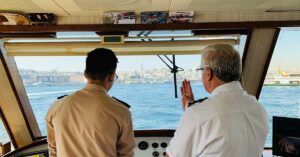US Visa Interview: Terms to Remember
US Visa interview for seafarers requires enough preparation to avoid waste of time, money, and effort. The list of terms and definitions below can help you prepare and refresh your brain of those long forgotten college terms.
You might also want to check some US Visa general interview questions to add up to your gear.
TRIM – the difference between aft and forward draft.
STABILITY – ability of the ship to return to its original position after the disturbance of outside force.
DRAFT – the submerged body of the ship measured from the keel to the water line.
METEOROLOGY – study of science that deals with the study of phenomena. Things that happen and observed in the atmosphere.
NAVIGATION – art of navigating a ship safely from one place to another in the least possible time.
SEAMANSHIP – the efficient work of a seaman on-board.
ELECTRONIC NAVIGATION – kind of navigation that uses electronic devices such as RADAR, Radio Direction Finder to navigate the ship.
BALLASTING – a process of putting water in the ballast tank so that the ship will be upright.
BUOYANCY – is the upward vertical support by the water in which the vessel is floating.
DEAD RECKONING – the process of calculating one’s current position by using a previously determined position, and advancing that position based upon known or estimated speeds over elapsed time, and course.
WINDLASS – is used to raise and lower the anchor.
WINCH – is used to pull in, let out, or adjust tension of a rope.
CAPSTAN – is used to secure mooring lines.
ANCHOR – is used to prevent the ship from drifting.
SOLID MENSURATION – process of knowing the dimension, volume, or area of any figure.
SALT/FRESH WATER – when entering salt water area, the draft of your ship decreases. While when entering fresh water area, the draft of your ship increases.
FOG – is a cloud whose base is low enough to restrict visibility. It is composed of droplets of water or ice crystals formed by crystallization of water vapor in the air.
CLOUDS – numerous tiny droplets of water or ice crystals formed by condensation of water vapor in air.
CLIMATE – refers to the prevalent or meteorological characteristic of a region.
MARITIME LAW – is a part of commercial laws, which strictly relates to shipping and its incidents. It is the law of the sea and governs acts arising out of maritime commerce.
EARTH – approximately an oblate spheroid. However, for many navigational purposes, the Earth is assumed to be sphere without intolerable end.
DISTANCE – is the spatial separation of two points and is expressed as the length joining them.
COURSE – the direction in which a vessel is steered or intended to be steered.
BACK – intended or desired horizontal direction of travel with respect to the Earth and also the path of intended travel.
FIX – is the common intersection of two or more lines of position obtained from simultaneous observations.
PILOTING – is navigation involving frequent or continuous determination of position or LOP relative to geographic points.
SAILING – is a various method of solving various problems involving course, distance, DLAT, DLO, ETD, ETA, and the duration of steaming time.
SEXTANT – is a handheld instrument for measuring the angle between the line of sight of two points by bringing into coincide at the eye of the observer. A double reflecting instrument for measuring angles primarily altitudes of the celestial bodies.
LIST – is a transverse angle of inclination of a vessel caused by external forces acting on the ship that affects the vessel’s stability.
DISPLACEMENT – is the weight of the vessel equal to the weight of the water being displaced.
MATHEMATICS – is the study of numbers, it involves addition, subtraction, multiplication, and division.
ALGEBRA – is the branch of Mathematics that deals with the algebraic expressions and variables and represented by a letter.
TRIGONOMETRY – is the branch of Mathematics which deals with the study of triangles and the relationship between their sides and the angles between these sides.
THERMODYNAMICS – is the study of heat, temperature, heat expansion, and its changes.
PHYSICS – is an applied science which deals on matter and its motion through space and time, along with related concepts such as energy and force.
CHEMISTRY – is the about elements and chemical composition of a substance.
CALCULUS – is a branch of Mathematics focused on limits, functions, derivatives, integrals, and infinite series.
GEOMETRY – branch of Mathematics concerned with questions of shape, size, and their properties.
MECHANICS – branch of science dealing with the study of motion.
DYNAMICS – the study of the causes of motion and changes in motion.
KINEMATICS – is the branch of classical mechanics that describes the motion of points, bodies (objects) and systems of bodies (groups of objects) without consideration of the causes of motion.
POTENTIAL ENERGY – energy not in use.
KINETIC ENERGY – energy in motion.
ENTROPY – is the measure of a system’s thermal energy per unit temperature that is unavailable for doing useful work.
ENERGY – is the ability to do work.
ENGINEERING – is an applied science which deals with construction and maintenance.
COMMUNICATION – is an act of passing or transmitting ideas or information between sender and the receiver.
Related: US Visa Application: Interview General Questions
Share this content:
 You might also want to check some
You might also want to check some 













1 comment